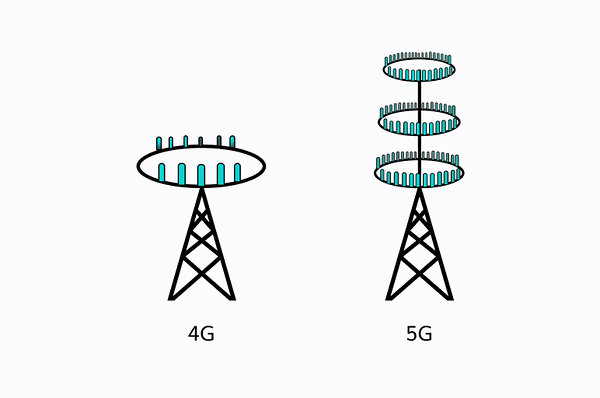5G stands for fifth-generation cellular network technology, the next significant development in wireless communications. We've been told that 5G is the foundation for realising the full potential of IoT. Even though the same is said about NB-IoT and LTE-M.
While companies talk about the 5G "revolution" and governments push to win a "race," it's not easy to understand the innovation enabling the 5G revolution.
In this article, we'll get you up to speed on what are the technological advancements enabling the 5G. And you'll find out if and how you should prepare for the launch.
Quick recap
Here are the main facts about the 5G:
-
Downlink peak data rate: 20 Gbit/s, uplink peak data rate: 10 Gbit/s.
-
In dense areas, experienced downlink data rate 100 Mbit/s, uplink 50 Mbit/s.
-
Can handle at least 1M connected devices per 1km2.
-
Covers connections and speeds when driving up to 500 km/h, for example, in trains.
-
Interruption time, when migrating between radios, should be zero.
These points were set out in 2015 as a part of the IMT-2020 Standard (International Mobile Telecommunications), which specifies 5G networks, devices, and services. As the name suggests, the standard is aimed to be completed by 2020.
IMT-2020 is a followup standard for previous technologies like 3G (IMT-2000) and 4G (IMT-Advanced).
Fifth-generation networks are built on several new technologies and technical standards. Let's see how far the new generation of cellular connectivity has become.
Technological solutions that make 5G happen
A series of new solutions must be implemented to fulfil the high specifications and goals set for 5G. Each technology comes with its limitations, which the next solution aims to fix.
That's why there's a set of 5 new implementations that lay the foundation for a full 5G rollout.
We will try to keep the explanations understandable of each technology, but bear with us for now.
Millimetre Waves
Millimetre-wave technology allows transmission of data on high frequencies between 30 GHz and 300 GHz. In comparison, 4G uses frequencies below 6 GHz.
The high frequencies allow faster speeds and are also less cluttered with existing cellular data.
But millimetre waves can not travel through buildings or other obstacles. It's has been found that even rain might absorb the signal. That is why there's a need for the next technology - Small Cell.
Small Cell
Before 5G, we deployed high powered cell towers that could broadcast signals over long distances.
But as we learned from the previous point, millimetre waves don't travel through obstacles. So, more cell towers need to cover the same area as before.
For a successful introduction of 5G, we need to deploy many small cells that can hand over the signal from one cell to another when a device travels from one point to another.
Massive MIMO
MIMO stands for Multiple Input Multiple Output. It's a cell tower with multiple antennas for receiving and sending. MIMO, as such, has been used already in telecommunications.
With the introduction of 5G, the number of different antennas increases tremendously. The more significant amount of antennas enhance connectivity and offer better speeds.
And yes, Massive MIMO comes with its cons. All of these antennas broadcasting in all directions can cause severe interference. That's why there's something called Beamforming.
Beamforming
Beamforming allows the sending of a specific stream of data to a particular user. This will prevent interference and let the cell to handle more devices at once.
Full Duplex
Currently, antennas are capable of only transmitting or receiving data at any given time. Until now, the solution uses different frequencies for transmitting and receiving or for taking turns in sending and receiving.
Full Duplex will allow you to send and receive on the same wavelength, again boosting the speeds and number of simultaneously connected devices.
5G NR
5G New Radio (NR) is the Radio Access Technologie(RAT) developed for your device to connect to 5G, the new standard for the air interface.
5G New Radio is RAT beyond LTE. In simple terms, 5G NR will be the new standard that will replace 4G LTE and soon you will see it displayed on the top of your phone.
To complicate things a bit further there are two modes for 5G NR:
-
Non-Standalone mode (NSA)
This mode will rely on existing 4G LTE infrastructure providing higher data-bandwidth and reliable connectivity. It's easier and cheaper for the operators to implement. Still, it will lack the core features like ultra-low latency and higher capacity of 5G.
-
Standalone mode (SA)
This is what we can refer to as real 5G. SA mode will pave the way for new services which need the full potential like ultra-low latency and low power of 5G.
The industry hasn't formed a clear consensus on which to implement first.
Some carriers are looking to launch the NSA mode to boost 5G adoption quickly. Others don't see the value in NSA mode and plan to implement the full SA mode from the beginning.
5G NR Standalone mode (SA) complete specification
Standalone mode is the actual core 5G that brings all the vast improvements for consumers and IoT/M2M deployments. The core system brings us three prominent use cases:
-
eMBB (enhanced Mobile Broadband)
eMBB aims to support consumer applications like HD video streaming and gaming. High peak data rates and support for high-speed mobility.
-
URLLC (Ultra-Reliable Low Latency Communications)
The reliability of URLLC will support critical applications like eHealth, ultra-low latency(less than 1 ms air interface) will enable autonomous vehicles and remote control in manufacturing.
-
MMTC (Massive Machine Type Communications)
MMTC will continue to support the massive IoT deployments. It can connect millions of low-power devices without congestion.
If this article ended up too technical, then read how 5G fits into IoT and how the new technologies impact the end-user.
We believe that the points covered in this post are the most important to understand 5G technology or lay the groundwork for doing more in-depth research.
If you have any further questions about hardware modules, 5G SIM cards, please contact us at hacking[at]1oT.com.








